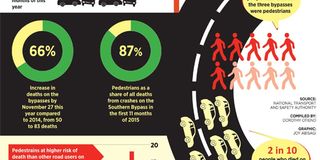New bypasses jerk up road crashes

GRAPHIC: JOY ABISAGI
What you need to know:
- The roads are smooth, with many lanes and vehicles travelling at high speeds yet there are few footbridges and clearly marked pedestrian crossings.
- On the Southern Bypass, almost 90 per cent of deaths are of pedestrians.
- Mr Munyao named the stretch of the road that runs through the Kibera slum as a black spot. The most affected sections are the Raila and Gatwikira sections within Kibera slums.
In the first 11 months of this year, one in seven road crash deaths in Nairobi happened on the bypass roads, a Nation Newsplex examination of road traffic data from the National Transport and Safety Authority (NTSA) reveals.
A total of 133 people have been killed on the three bypasses since the first one was opened in 2014, according to the statistics.
In 2014, 50 people were killed on the three roads and by November 27 this year, that number had already been surpassed. Even though there is still have one month to go to the end of the year, 83 deaths have been reported so far, a 66 per cent increase.
"The crashes on these areas are because of negligence because there is a tunnel that people do not use."
On the Eastern Bypass, 37 people were killed from January to November, followed by Northern Bypass with 31 and Southern Bypass with 15.
The high number of deaths has led to the entry of the bypasses onto the list of high risk roads in Nairobi which initially had six roads – Mombasa Road, Thika Road, Kagundo Road, North Airport Road, Waiyaki Way and Jogoo Road. Together, the nine high-risk roads account for almost half of deaths on Nairobi roads.
Traffic casualties are not the only factors used to determine whether a road is high-risk. There is also human-vehicle conflict and deaths per kilometre, says Dr Duncan Kibogong, Deputy Director of Safety Strategies and County Committees at NTSA.
The most vulnerable users on the bypasses are pedestrians by far, followed by passenger, drivers and motorcyclists.
FAILURE TO PLAN
Pedestrians made up six out of ten deaths, passengers two out of ten, motorcyclists and drivers about seven per cent each. Pedal cyclists and pillion passengers jointly made up less than two per cent of total deaths.
On the Southern Bypass, almost 90 per cent of deaths are of pedestrians.
"The areas through which the roads pass were empty fields but once the bypasses were completed people sold the land to developers who came in and built houses, shopping centres and other building by the roads. The roads design had not taken that into consideration."
What is happening on the bypasses is a perfect example of the conflict between road users. The roads are smooth, with many lanes and vehicles travelling at high speeds yet there are few footbridges and clearly marked pedestrian crossings. The few that are there are often shunned by pedestrians.
The result is that the two compete for use of the road, and naturally the pedestrians trying to cross the roads lose out.
So were the bypasses that are relatively new designed without safety in mind? Dr Duncan Kibogong told Newsplex that it was not so much the road designs but the failure of different stakeholders to plan for the future.
“The areas through which the roads pass were empty fields but once the bypasses were completed people sold the land to developers who came in and built houses, shopping centres and other building by the roads. The roads design had not taken that into consideration,” he said.
The Eastern Bypass runs from Mombasa Road through Cabanas, Pipeline, Njiru and Thika Road onwards. NTSA Road Safety Director Mr Mathew Munyao said all the bypasses are “speed roads” and the Eastern one was initially constructed without footbridges for pedestrians to cross.
He named areas where crashes occur frequently as Pipeline and the stretch between Cabanas and Taj Mall. “A footbridge was recently put up but most people don’t use it hence they are hit by speeding vehicles,” he said.
Mr Munyao said plans are underway to put up guard rails that will deter pedestrians from crossing the road and use the foot bridge. He also said motorists are at risk on the Eastern Bypass because of many trucks that use the road.
'HIGH SPEED HIGHWAY'
“Dangerous overtaking by small vehicles cause crashes on this road, which is a single carriageway, because they are inpatient and want to overtake slow moving trucks,” he said.
Most head-on collisions on the bypass occur along Embakasi area and Ruai and Ruiru junctions.
The Northern Bypass connects Thika Road to Ruaka. The black spots on this road have been identified as the junction connecting Kiambu Road to the bypass, as well as Ruaka area. The main cause of death is speeding, as the road has few sections for pedestrian crossing.
The Southern Bypass, opened this year, runs from Kikuyu to Mombasa Road, through Ngong Road and Langata Road. “This is a high speed highway with no clear provision for pedestrians. There is lack of homogeneity of traffic, people walking slowly and cars speeding,” he said.
Mr Munyao named the stretch of the road that runs through the Kibera slum as a black spot. The most affected sections are the Raila and Gatwikira sections within Kibera slums.
“The crashes on these areas are because of negligence because there is a tunnel that people do not use,” he said. He said chain links, fence to prevent pedestrians from crossing and proper signage have been put up on the affected areas.
Dr Kibogong says to avoid what has happened to the bypasses from being repeated elsewhere, in future, the Kenya National Highway Authority, NTSA and other stakeholders in government must control development of human settlements near highways.





